
The South Australian cobbler, better known as the soldier but also known as the cobbler, devilfish or soldierfish, is a species of marine ray-finned fish, a waspfish, belonging to the subfamily Tetraroginae which is classified within the family Scorpaenidae, the scorpionfishes and their relatives. It is endemic to southern Australia. It is the only species in the monotypic genus Gymnapistes.
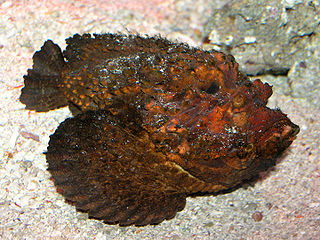
Synanceiinae is a subfamily of venomous ray-finned fishes, waspfishes, which is classified as part of the family Scorpaenidae, the scorpionfishes and their relatives. These fishes are found in the Indo-Pacific oceans. They are primarily marine, though some species are known to live in fresh or brackish waters. The various species of this family are known informally as stonefish, stinger, stingfish and ghouls. Its species are known to have the most potent neurotoxins of all the fish venoms, secreted from glands at the base of their needle-like dorsal fin spines. The vernacular name, stonefish, for some of these fishes derives from their behaviour of camouflaging as rocks. The type species of the family is the reef stonefish.

The leaf goblinfish is a species of marine ray-finned fish, a waspfish belonging to the subfamily Tetraroginae, which is classified as part of the family Scorpaenidae, the scorpionfishes and their relatives. This is the only species in the monotypic genus Neovespicula. It is found in coastal habitats of the Indo-West Pacific region.

Tetraroginae is a subfamily of marine ray-finned fishes, commonly known as waspfishes or sailback scorpionfishes, belonging to the family Scorpaenidae, the scorpionfishes and their relatives. These fishes are native to the Indian Ocean and the West Pacific. As their name suggests, waspfishes are often venomous; having poison glands on their spines. They are bottom-dwelling fish, living at depths to 300 metres (980 ft). These creatures usually live in hiding places on the sea bottom.
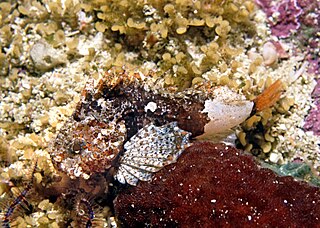
The smoothskin scorpionfish is a species of ray-finned fish, a waspfish belonging to the subfamily Tetraroginae of the family Scorpaenidae, the scorpionfishes and their relatives. It is the only species in the monotypic genus Coccotropsis. This species is endemic to the seas off South Africa.
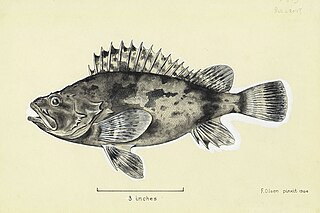
The bullrout, also commonly called freshwater stonefish or kroki, is a pale yellowish to dark-brown coloured fish that lives in tidal estuaries and slow-flowing streams in eastern Australia, from Southern New South Wales to northern Queensland, Australia. It has on a very infrequent occurrence been caught at sea. Its spines are venomous. It is the only member of the genus Notesthes. It is often confused with the true stonefish.
Leptosynanceia is a monotypic genus of ray-finned fish belonging to the subfamily Synanceiinae, the stonefishes, which is classified within the family Scorpaenidae, the scorpionfishes and relatives, its only species is Leptosynanceia asteroblepa which is called the mangrove stonefish in Malaysia. This species native to the brackish and fresh waters of Southeast Asia. This species grows to a total length of 23 centimetres (9.1 in). This species is an extremely dangerous fish whose venom can cause a human to die within 1 to 2 hours after contact. The pain caused by the venom is described as "agonizing".

Ablabys is a genus of marine ray-finned fishes, waspfishes belonging to the subfamily Tetraroginae, which is classified as part of the family Scorpaenidae, the scorpionfishes and their relatives. The fishes in this genus are found in the Indian Ocean and the western Pacific Ocean.

The marbled spinefish, also known as the yellow waspfish, is a species of ray-finned fish, a waspfish belonging to the subfamily Tetraroginae of the family Scorpaenidae, the scorpionfishes and their relatives. It is the only species in the monotypic genus Cottapistus. This species is found in the Indo-West Pacific.

Glyptauchen is a monotypic genus of marine ray-finned fish belonging to the subfamily Tetraroginae, the waspfishes. The only species in the genus is the goblinfish, also known as the saddlehead or saddlehead goblinfish which is endemic to the southern coasts of Australia. The goblinfish has venomous spines in its fins.
Liocranium is a small genus of marine ray-finned fishes, waspfishes belonging to the subfamily Tetraroginae, which is classified as part of the family Scorpaenidae, the scorpionfishes and their relatives. The fishes in this genus are found in the eastern Indian Ocean and the western Pacific Ocean.
Neocentropogon is a poorly known genus of marine ray-finned fishes, waspfishes belonging to the subfamily Tetraroginae, which is classified as part of the family Scorpaenidae, the scorpionfishes and their relatives. The fishes in this genus are native to the Indian Ocean and the western Pacific Ocean.

Ocosia is a genus of ray-finned fishes, waspfishes belonging to the subfamily Tetraroginae, which is classified as part of the family Scorpaenidae, the scorpionfishes and their relatives. These fish are found in the Indian Ocean and western Pacific Ocean.

Paracentropogon is a genus of ray-finned fishes, waspfishes belonging to the subfamily Tetraroginae, which is classified as part of the family Scorpaenidae, the scorpionfishes and their relatives, These fish are found in the Indian Ocean and western Pacific Ocean.

Pseudovespicula is a genus of venomous ray-finned fishes, waspfishes belonging to the subfamily Tetraroginae, which is classified as part of the family Scorpaenidae, the scorpionfishes and their relatives. It has been considered to be a monotypic genus, containing only the type species, Pseudovespicula dracaena, but some authorities classify three species within the genus. The genus is found in the Indo-Pacific region.

Richardsonichthys, is a monotypic genus of marine ray-finned fish belonging to the subfamily Tetraroginae, the waspfishes, which is classified as part of the family Scorpaenidae, the scorpionfishes and their relatives. The only species in the genus is the whiteface waspfish, also known as the whitebelly roguefish, rouge fish, Torres Strait soldier fish or Richardson's waspfish. This species is native to reefs of the Indian Ocean and the western Pacific Ocean.

Snyderina is a genus of ray-finned fishes, waspfishes belonging to the subfamily Tetraroginae, which is classified as part of the family Scorpaenidae, the scorpionfishes and their relatives. These fishes are found in the western Indian Ocean and the western Pacific Ocean.
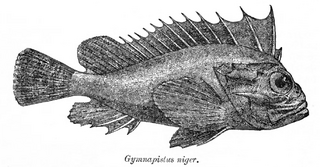
Tetraroge is a genus of ray-finned fishes, waspfishes belonging to the subfamily Tetraroginae, which is classified as part of the family Scorpaenidae, the scorpionfishes and their relatives. These fishes are native to the Indian Ocean and the western Pacific Ocean.

Vespicula is a genus of venomous ray-finned fishes, waspfishes belonging to the subfamily Tetraroginae, which is classified as part of the family Scorpaenidae, the scorpionfishes and their relatives. These fishes are native to the Indian Ocean and the western Pacific Ocean. Although FishBase recognises this genus as valid, other authorities, such as the Catalog of Fishes regard it as a synonym of Trichosomus.
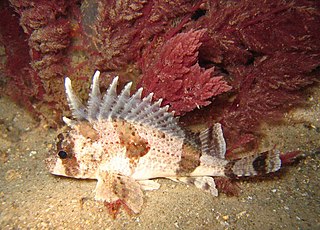
The Eastern fortescue, also known as the fortesque, Southern fortescue, fortie or Southern bullrout, is a species of ray-finned fish, a waspfish belonging to the subfamily Tetraroginae of the family Scorpaenidae, the scorpionfishes and their relatives. It is found the coastal waters of eastern Australia.
















